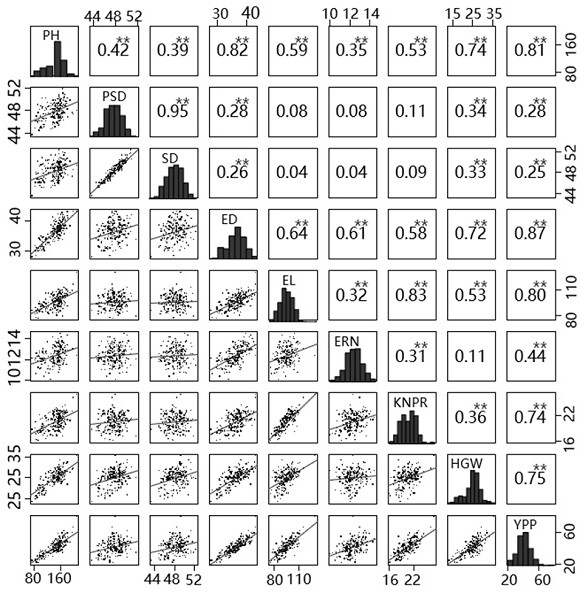Mutant allele of ZmAMP1 gene and application thereof
An allele and gene technology, applied in the field of alleles, can solve problems such as dwarfing and lack of breeding application value, and achieve the effects of reducing plant height, improving lodging resistance and yield, and promoting early harvesting.
- Summary
- Abstract
- Description
- Claims
- Application Information
AI Technical Summary
Problems solved by technology
Method used
Image
Examples
Embodiment 1
[0083] Example 1 F2:3 population phenotype analysis and QTL mapping
[0084] According to the semi-dwarf and early flowering characteristics of the maize mutant grmm, the F2:3 segregation population was constructed by crossing Si273 with grmm. In the F2:3 population, the traits related to plant height (including plant height, height of ear position and height above ear), traits related to flowering period (including heading stage, powder loosening stage, silking stage), ear traits (ear length and ear diameter) and yield-related traits (including ear row number, kernel number per row, 100-grain weight and yield per plant). For each of the tested traits, there were significant differences between parents (Table 1). The coefficients of variation of these traits were between 3.13% and 25.27%, and the broad-sense heritability was between 0.55 and 0.89, indicating that these traits were mainly controlled by genetic factors. Correlation analysis of the tested traits showed that pla...
Embodiment 2
[0098] Example 2 qPH1 Fine Mapping and Allelism Test
[0099] Using plant height as the target trait for qPH1 fine-mapping, it is located in the interval of 273-277cM ( figure 2 A), the location roughly corresponds to the physical location of 281.8-289.3 Mb (B73 reference genome version 3). A preliminary screening of the exchanged individual plants was performed using markers D2 and D25 (see Table 5 for primer sequences), and the positions of D2 and D25 were 281.2 and 289.9 Mb, respectively. Using the BC2F2 population, the QTL region was narrowed down to the region between G2 and R18 (see Table 5 for primer sequences), which is 227 kb in length according to version 3 of the maize B73 reference genome. Using the BC2F3 population, the QTL region between R14 and G13 was further narrowed down to 16 kb (see Table 5 for primer sequences). Two candidate genes (GRMZM2G010353 and GRMZM2G011385) were found in this region ( figure 2 B).
[0100] Table 5 Primer sequence information ...
Embodiment 3
[0110] Example 3 Mining of ZmAMP1 Variation Sites
[0111] First, qPH1-based near-isogenic lines (NILs) were screened in the BC3F3 generation, and NILs containing grmm fragments are called NILs grmm , containing the Si273 fragment called NIL Si273 , extract the RNA of NILs and parental vegetative growth V6 stage young stem tissue, and compare ZmAMP1 between NILs by transcriptome analysis and real-time quantitative PCR (RT-PCR) (NIL Si273 and NIL grmm ) and the difference between the parents (grmm and Si273).
[0112] qRT-PCR showed that NIL Si273 and NIL grmm There was no significant difference between the parental lines and the parental lines ( Figure 4 A), which shows that the semi-dwarf phenotype of grmm is not related to the expression of ZmAMP1. Therefore, the genomic sequence of ZmAMP1_grmm (after the ATG transcription start codon) was compared with that of ZmAMP1 from Si273, B73, CML247, EP1 and F7 (sequences of B73, CML247, EP1 and F7 are from www.maizegdb.org) ...
PUM
 Login to View More
Login to View More Abstract
Description
Claims
Application Information
 Login to View More
Login to View More - R&D
- Intellectual Property
- Life Sciences
- Materials
- Tech Scout
- Unparalleled Data Quality
- Higher Quality Content
- 60% Fewer Hallucinations
Browse by: Latest US Patents, China's latest patents, Technical Efficacy Thesaurus, Application Domain, Technology Topic, Popular Technical Reports.
© 2025 PatSnap. All rights reserved.Legal|Privacy policy|Modern Slavery Act Transparency Statement|Sitemap|About US| Contact US: help@patsnap.com



